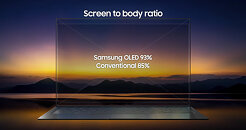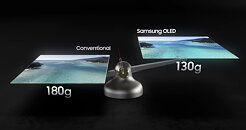Thursday, January 14th 2021

Samsung to Introduce OLED-Powered Laptops With Under-Display Webcam
Samsung this year aims to bring OLED panels in laptops closer to mainstream, with the company already announcing it would be scaling its OLED screens to serve the 13,3-16" diagonal-craving population with the best visual quality available. The company is apparently aiming to take this further by investing into under-display webcams, which would prevent machines from shipping with large top bezel designs engineered to accommodate them. It also skirts implementation of other, more exotic solutions such as the one found in the Huawei Matebook X Pro - where the webcam is located in a mechanical pop-up on the keyboard area, and mostly shows viewers the inside of your nostrils.
Samsung says that this under-display design should allow laptop makers to achieve up to 93 percent screen-to-body ratio for an immersive viewing experience. Do keep in mind that such a design was implemented only once in the industry in ZTE's Axon 20 smartphone, which incidentally featured diminished selfie camera and display quality due to it being under-display, which even led to resolution compromises on the area of the display that sits over the camera. The idea in ZTE's phone - and is the same for Samsung here - is that the segment of the OLED display that covers the camera will turn translucent whenever the optics are activated. In the ZTE phone, this resulted in clear quality compromises. We'll see if Samsung fares better. There is currently no time to market on such OLED panels, however.
Source:
Sciencemint
Samsung says that this under-display design should allow laptop makers to achieve up to 93 percent screen-to-body ratio for an immersive viewing experience. Do keep in mind that such a design was implemented only once in the industry in ZTE's Axon 20 smartphone, which incidentally featured diminished selfie camera and display quality due to it being under-display, which even led to resolution compromises on the area of the display that sits over the camera. The idea in ZTE's phone - and is the same for Samsung here - is that the segment of the OLED display that covers the camera will turn translucent whenever the optics are activated. In the ZTE phone, this resulted in clear quality compromises. We'll see if Samsung fares better. There is currently no time to market on such OLED panels, however.



29 Comments on Samsung to Introduce OLED-Powered Laptops With Under-Display Webcam
Personally I would rather see micro-LED type screens, but they're more than likely a few years away from consumer market.
Nothing like a webcam that looks up your nose maybe spot covid signs :cool: